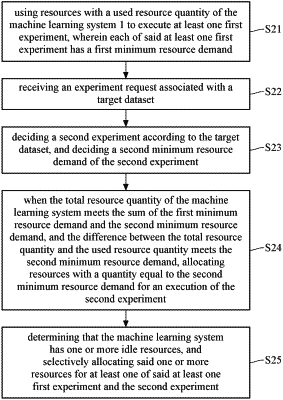| CPC G06F 9/50 (2013.01) [G06N 20/00 (2019.01); G06F 2209/501 (2013.01)] | 20 Claims |

|
1. A resource allocation method applicable for a machine learning system, and comprising:
using resources with a used resource quantity of the machine learning system to execute at least one first experiment, wherein each of said at least one first experiment has a first minimum resource demand;
receiving an experiment request associated with a target dataset;
deciding a second experiment according to the target dataset, and deciding a second minimum resource demand of the second experiment;
when a total resource quantity of the machine learning system meets a sum of the first minimum resource demand and the second minimum resource demand, and a difference between the total resource quantity and the used resource quantity meets the second minimum resource demand, allocating resources with a quantity equal to the second minimum resource demand for an execution of the second experiment; and
determining that the machine learning system has one or more idle resources, and selectively allocating said one or more idle resources for at least one of said at least one first experiment and the second experiment,
wherein deciding the second minimum resource demand comprises:
according to execution efficiency data of the second experiment and a target execution performance, calculating the second minimum resource demand;
wherein the execution efficiency data of the second experiment comprises execution time of a single trial corresponding to a maximum occupied resource quantity, and the target execution performance indicates a target quantity of trials of the second experiment completed in a preset period.
|